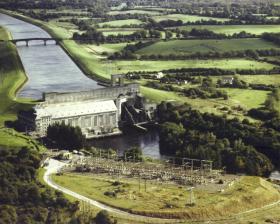Ardnacrusha Generating Station, Co. Clare
Published in 20th-century / Contemporary History, Features, Issue 1 (Jan/Feb 2010), Volume 18 The potential for harnessing power on the River Shannon had long been recognised, with plans dating back to an 1844 report published by Sir Robert Kane (1809–90), a Dublin-born chemist. A later proposal, known as ‘Frazer’s Scheme’, was inspired by similar work at Niagara Falls and was endorsed under the Shannon Water and Electric Power Act, 1901. As the cost was seen as prohibitive, however, the project was never realised.
The potential for harnessing power on the River Shannon had long been recognised, with plans dating back to an 1844 report published by Sir Robert Kane (1809–90), a Dublin-born chemist. A later proposal, known as ‘Frazer’s Scheme’, was inspired by similar work at Niagara Falls and was endorsed under the Shannon Water and Electric Power Act, 1901. As the cost was seen as prohibitive, however, the project was never realised.
The present scheme came to fruition through the exertions of a Drogheda-born engineer, Dr Thomas Aloysius McLoughlin (1896–1971), who in 1922 joined the firm of Siemens-Schukertwerke in Berlin. Commissioned by Patrick McGilligan (1889–1979), minister for industry and commerce, to submit a plan for a generating station on the River Shannon, McLoughlin proposed a scheme that at over £5 million was almost one-fifth of the entire annual budget available to the Irish Free State.
The considerable expenditure, sanctioned by the government after much political debate, was necessitated not only by the generating station but also by the head- and tail-race canals constructed along the River Shannon, which was spanned by four new bridges, and the extensive system of culverts and sluices enhancing the fall in water levels between Lough Derg and the Shannon. Fish passes were also required to allow the safe passage of salmon past the power station.
Work on the project, officially known as the Shannon Scheme, began in 1925, and the Electricity Supply Board (ESB), which was to take over responsibility for the station, was established by Minister McGilligan in 1927. Public interest was encouraged, with bus and train tours to the site. Despite a major labour dispute, a penalty clause in the contracts ensured that work was completed on time in 1929, with only a comparatively minor budget overrun.
The centrepiece of the Shannon Scheme remains the impressive generating station at Ardnacrusha, a steel-framed building designed to house six massive turbines. Ultimately, only four turbines were installed: three (1929) of the vertical shaft type patented by James Bicheno Francis (1815–92), and one (1934) of the vertical shaft type developed by Viktor Kaplan (1876–1934). Interestingly, the role played by Siemens-Schukertwerke in the scheme appears to have influenced the appearance of the station, the remarkably high-pitched roof with rows of miniature dormer windows exhibiting a marked Germanic character.
At the time of completion, the station at Ardnacrusha had the distinction of being the largest hydroelectric station in the world, although that title would quickly be conceded to the Boulder Dam, latterly known as the Hoover Dam, begun in 1930. Its importance in supporting the economy of a new independent Ireland cannot be overstated, with the generating station intrinsically linked to rural electrification from the 1930s onwards.
The success of the station attracted international interest and it was adopted as a model for similar electrification projects across the world. Its significance continues to be recognised, and in 2002, its 75th anniversary, the American Institute of Electrical and Electronics Engineers (IEEE) identified the project as a milestone of twentieth-century engineering, while the American Society of Civil Engineers (ASCE) identified the site as an International Historic Engineering Landmark. HI
Damian Murphy is NIAH Survey Controller. Series based on the National Inventory of Architectural Heritage’s ‘building of the month’, www.buildingsofireland.ie.
















